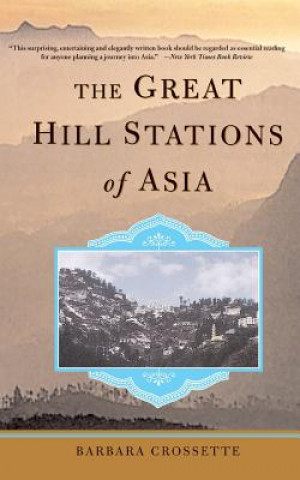
Dostawa
Doradca ds. zakupów
16 131 539 książek w 175 językach







Pokaż wszystkie języki (175)





Jednak się nie przyda? Nic nie szkodzi! U nas możesz zwrócić towar do 30 dni
 Bon prezentowy
O dowolnej wartości
Bon prezentowy
O dowolnej wartości
Bon prezentowy to zawsze dobry pomysł. Obdarowany może za bon prezentowy wybrać cokolwiek z naszej oferty.
Great Hill Stations Of Asia
 Angielski
Angielski
 46 b
46 b
30 dni na zwrot towaru
Mogłoby Cię także zainteresować


For the European and later the American colonial soldier, the civil administrator and his clerk, the merchant, the missionary, and the families who followed them east of Suez, daily life was less a matter of advancing the glory of God or empire than a battle for survival against sunstroke, dysentery, cholera, malaria, and a host of other unnamed deadly fevers as well as little-examined, vague indispositions that in hindsight would probably be diagnosed as clinical symptoms of depression. Later, medical scholars coined a phrase for it: "tropical fatigue." Pity John Ouchterlony. By the time they brought him to the healing hills, it was too late. On April 29, 1863, Lieutenant Colonel Ouchterlony of the Royal Madras Engineers died of "jungle fever brought on by exposure while in the execution of his duty," says a memorial plaque--one of many--at St. Stephens Church in Ootacumund, a British colonial town in the Nilgiri Hills of southern India. Others were luckier. They got to Ooty in time and survived the perilous East, at least for another season, by rising above its pestilential lower reaches. On litters, in chairs, on ponies, by foot if they were able, Europeans in Asia nearly two centuries ago began climbing into the hills in search health, relaxation, and sometimes their sanity.They called the refuges they created--little European towns carved from rocky mountainsides or nestled in the meadows of high plateaus--"hill stations." Colonialism came and went, but the hill stations remain. They are no longer European, but most have not lost their unique appeal. After all, the plains still fry in the sun and the cities of Asia have only grown larger, noisier, and more polluted. New generations of Asians are rediscovering hill stations and turning them into tourist resorts with luxury hotels and golf courses. Hill stations still cling to their history, and the story they tell reveals a lot about how colonial life was lived. They also have a future, if environmental damage and overpopulation do not destroy the forested hills and mountains that gave them their spectacular settings and pleasant climates.Hill stations began to appear, albeit at different times in different places, when the era of initial exploration and conquest was waning, wives and families arrived in substantial numbers, and life had become a bit more routine. By then, colonial societies could take stock of their longer-term needs and, regrettably, look for ways to build walls around themselves to shut out native populations. Through the age of European mercantile empire building and colonialism that began with the turn of the sixteenth century, hill stations were largely a nineteenth-century phenomenon. Most were established between 1820 and 1885, though the Dutch were early with Bogor in Indonesia and the French came later with Dalat in Vietnam and the Americans with Baguio in the Philippines. The British themselves built a second generation of hill stations after World War I in southeast Asia.In early 1997, Barbara Crossette set off on a journey of several months to see Asia anew through its great hill stations, moving from mountain to mountain from Pakistan, across India, to Sri Lanka, Burma, Malaysia, Vietnam, and the Philippines. A year earlier, Crossette had made a trip to the highlands of Indonesian Sumatra, the land of the Minangkabau and Batak people, where the idea of this kind of journey came together.
Informacje o książce
 Angielski
Angielski




 Jak kupować
Jak kupować





























